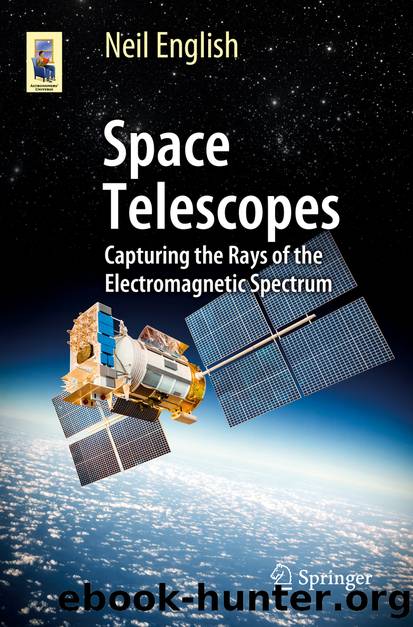Space Telescopes by Neil English

Author:Neil English
Language: eng
Format: epub
Publisher: Springer International Publishing, Cham
The Chandra X-Ray Observatory
Like all other great telescopes, the Chandra X-Ray telescope originated with a good idea. In 1976 the Chandra X-ray Observatory (called AXAF at the time) was proposed to NASA by the Italian high energy astrophysicist, Riccardo Giacconi and the American astronomer, Harvey Tananbaum. Preliminary work began the following year at Marshall Space Flight Center (MSFC) and the Smithsonian Astrophysical Observatory (SAO). In the meantime, in 1978, NASA launched the first imaging X-ray telescope, Einstein (HEAO-2), into orbit. Work continued on the AXAF project throughout the 1980s and 1990s. As a cost cutting measure, the spacecraft was redesigned in 1992. Four of the twelve planned mirrors were eliminated, as well as two of its six scientific instruments. AXAF’s planned orbit was also altered to an elliptical one, reaching one third of the way to the Moon ’s at its farthest point. Unfortunately, this precluded the possibility of improvement or repair by the space shuttle but had the advantage of placing the spacecraft above the Earth ’s radiation belts for most of its orbit. AXAF was assembled and tested by TRW (now Northrop Grumman Aerospace Systems) in Redondo Beach, California.
The telescope was renamed Chandra as the result of a contest held by NASA in 1998, which drew more than 6000 submissions from all around the world. The contest winners—Jatila van der Veen and Tyrel Johnson (then a high school teacher and high school student, respectively), suggested the name in honor of the Nobel Prize–winning Indian astrophysicist Subrahmanyan Chandrasekhar (1910–1995). He is known for his work in determining the maximum mass of white dwarf stars (the so-called Chandrasekhar Limit), leading to greater understanding of high energy astronomical phenomena such as neutron stars and black holes .
Originally scheduled to be launched in December 1998, the spacecraft was delayed several months, eventually being launched in July 1999 by Space Shuttle Columbia during STS-93 under the command of a female astronaut, Eileen Collins. Weighing in at a whopping 22,753 kilograms (50,162 lb.), it was the heaviest payload ever launched by the space shuttle, a consequence of the two-stage Inertial Upper Stage booster rocket system needed to transport the spacecraft to its high, elliptical orbit extending anywhere from about 9940 miles (16,000 kilometers) to 82,650 miles (133,000 kilometers) from Earth . During its maneuvers from one target to the next, Chandra slewed more slowly than the minute hand on a clock.
Within just weeks after its successful launch, Chandra began returning data. It was operated by the SAO at the Chandra X-ray Center in Cambridge, Massachusetts, with assistance from MIT and Northrop Grumman Space Technology. The ACIS CCDs suffered particle damage during early radiation belt passages. To prevent further damage, the instrument was removed from the telescope’s focal plane during these passages. The resolution of the telescope is about 0.5 arc seconds and is remarkably efficient in terms of power consumption; just 2 kilowatts or about the same as a domestic hairdryer! Data from Chandra are transmitted via the Deep Space Network stations to the
Download
This site does not store any files on its server. We only index and link to content provided by other sites. Please contact the content providers to delete copyright contents if any and email us, we'll remove relevant links or contents immediately.
Tools of Titans by Timothy Ferriss(7811)
Turbulence by E. J. Noyes(7700)
Astrophysics for People in a Hurry by Neil DeGrasse Tyson(5000)
Secrets of Antigravity Propulsion: Tesla, UFOs, and Classified Aerospace Technology by Ph.D. Paul A. Laviolette(4990)
Design of Trajectory Optimization Approach for Space Maneuver Vehicle Skip Entry Problems by Runqi Chai & Al Savvaris & Antonios Tsourdos & Senchun Chai(4839)
Room 212 by Kate Stewart(4732)
Pale Blue Dot by Carl Sagan(4613)
The David Icke Guide to the Global Conspiracy (and how to end it) by David Icke(4377)
A Journey Through Divination and Astronomy by Publishing Pottermore(4248)
Apollo 8 by Jeffrey Kluger(3512)
Goodbye Paradise(3444)
Losing the Nobel Prize by Brian Keating(3425)
COSMOS by Carl Sagan(3346)
The Five People You Meet in Heaven by Mitch Albom(3334)
How to Read Water: Clues and Patterns from Puddles to the Sea (Natural Navigation) by Tristan Gooley(3239)
Brief Answers to the Big Questions by Stephen Hawking(3239)
How to Read Nature by Tristan Gooley(3077)
The Order of Time by Carlo Rovelli(3073)
A Brief History of Time by Stephen Hawking(2819)
